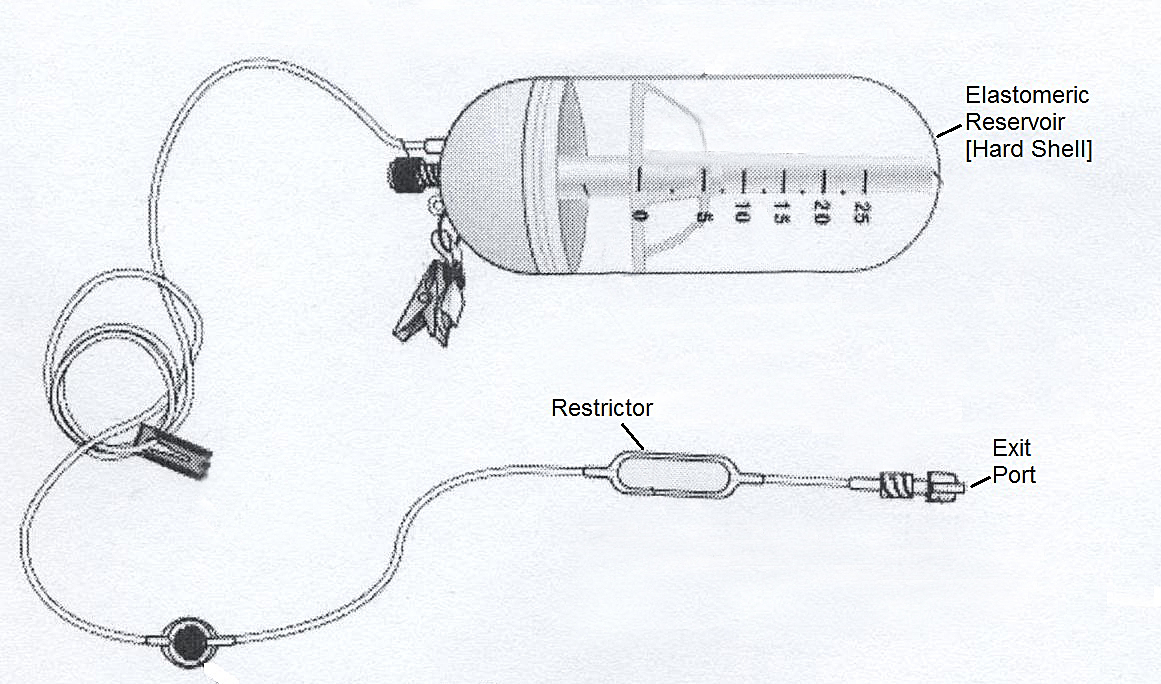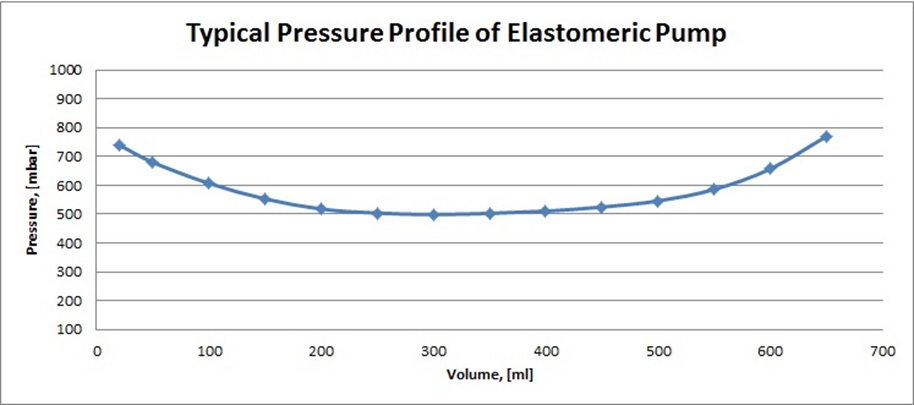Controlling of the Flow-Rate
Improved Way of Controlling the flow rate
A. Typical Elastomeric Pump
The majority of the present used mechanical pumps is elastomeric pumps; the pumps' reservoir is a kind of elastomeric "balloon" that
exerts continuous force over the medication once being filled. This force creates pressure in the reservoir; the pressure causes the
pump to infuse the medication.


All elastomeric pumps have a concaved pressure profile

1. Parameters that influence the flow rate in elastomeric pump
> Two parameters that influence the flow rate;
Pressure over the restrictor and the resistance created by the restrictor.
At the relevant range, the flow rate may be describe in the below equation
Fr=K * P / R
K; constant parameter
P; Pressure Over the Restrictor
R; Resistance of the Restrictor
> The Pressure Over the Restrictor (P) is the pressures differential between the inlet and the outlet of the restrictor.
Practically in typical elastomeric pump, this pressure is the pressure in the reservoir less the pressure at the pumps' exit port.
> The resistance of the restrictor affected by the restrictor design (typically capillary tube, may be labyrinth path), and the medication
viscosity. The medication viscosity is affected by the solution molecular composition and the solution temperature.
> The parameters that affected the flow rate in Elastomeric Pump may be classified in two categories
* Device Design Depended: (P) and (R) at room temperature (22°C ±2°C) with solution viscosity =~1 mPa·s
* Usage Depended: pressure at the pump exit port, type of solution, surrounding temperature
> Conclusions:
* The stability of the flow rate of typical elastomeric pump is limited; concaved profile (derive from the reservoir pressure profile).
* Depending on the nominal flow rate, the actual flow rate may significant affected (reduced) when there is relatively high pressure at
the pumps' exit port (for example; when set to 10ml/hr and connected to a 21G catheter or when the catheter insertion site
positioned 50cm or higher above the reservoir)
B. Elastomeric Pump with Pressure Compensation
(SmartBlock™, SmartInfuser PainPump™)
1. These types of pumps maintains stable flow rate regardless the changes in the reservoir pressures.
Furthermore, the flow rate isn't affected by changes in the pressure at the pumps' exit port.
2. Clinical Benefits
High level of versatility enables to set/design the pump to best meet the individual patient pain needs
> Re-fill, partial fill of the reservoir
> Convert the pump to a dual catheter by attaching FlowSpliier™
> Convert the pump to a dual flow rate pump by attaching additional Regulating Set utilizing Y-Tubing set.
3. Business Benefits
> Higher patient satisfaction
> Lower costs (reduced inventory)
Controlling of the Flow-Rate
Improved Way of Controlling the flow rate
A. Typical Elastomeric Pump
The majority of the present used mechanical pumps is elastomeric pumps; the pumps' reservoir is a kind of elastomeric "balloon" that exerts continuous force over the medication once being filled. This force creates pressure in the reservoir; the pressure causes the pump to infuse the medication.


All elastomeric pumps have a concaved pressure profile

1. Parameters that influence the flow rate in elastomeric pump
> Two parameters that influence the flow rate;
Pressure over the restrictor and the resistance created by the restrictor.
At the relevant range, the flow rate may be describe in the below equation
Fr=K * P / R
K; constant parameter
P; Pressure Over the Restrictor
R; Resistance of the Restrictor
> The Pressure Over the Restrictor (P) is the pressures differential between the inlet and the outlet of the restrictor. Practically in typical elastomeric pump, this pressure is the pressure in the reservoir less the pressure at the pumps' exit port.
> The resistance of the restrictor affected by the restrictor design (typically capillary tube, may be labyrinth path), and the medication
viscosity. The medication viscosity is affected by the solution molecular composition and the solution temperature.
> The parameters that affected the flow rate in Elastomeric Pump may be classified in two categories
* Device Design Depended: (P) and (R) at room temperature (22°C ±2°C) with solution viscosity =~1 mPa·s
* Usage Depended: pressure at the pump exit port, type of solution, surrounding temperature
> Conclusions:
* The stability of the flow rate of typical elastomeric pump is limited; concaved profile (derive from the reservoir pressure profile).
* Depending on the nominal flow rate, the actual flow rate may significant affected (reduced) when there is relatively high pressure at
the pumps' exit port (for example; when set to 10ml/hr and connected to a 21G catheter or when the catheter insertion site
positioned 50cm or higher above the reservoir)
B. Elastomeric Pump with Pressure Compensation
(SmartBlock™, SmartInfuser PainPump™)
1. These types of pumps maintains stable flow rate regardless the changes in the reservoir pressures.
Furthermore, the flow rate isn't affected by changes in the pressure at the pumps' exit port.
